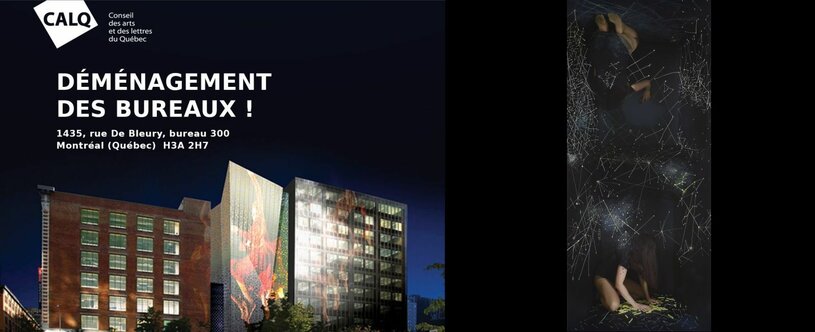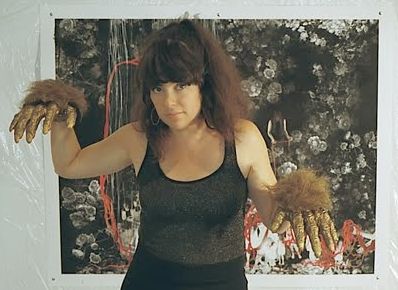Annie Baillargeon sur les murs du Conseil [in French only]

© Annie Baillargeon
L’artiste Annie Baillargeon This link will open in a new window a été choisie pour réaliser l’œuvre qui sera intégrée en permanence à l’Allée des arts et des lettres dans les nouveaux locaux administratifs montréalais du Conseil, dans l’édifice Wilder, adjacent à la Place des Festivals.

© Annie Baillargeon
En lice pour le prestigieux Prix Sobey pour les arts 2017, Annie Baillargeon vit et travaille à Québec. Sa démarche pluridisciplinaire conjugue différents médias (peinture, performance, photographie) pour explorer la représentation du corps et la dualité inhérente à la condition de la femme artiste. Elle a participé à de nombreuses expositions individuelles et collectives, et ses œuvres figurent dans des collections privées et publiques. Elle a été récemment interviewée dans Le SabordThis link will open in a new window.
Inspiré de la mission du Conseil, son projet est constitué de 11 panneaux de verre imprimés qui seront accrochés sur deux étages. Le processus de création sera terminé d’ici la fin du mois d’octobre et l’installation de l’œuvre est prévue pour la mi-novembre. La sélection s’est faite au terme d’un concours This link will open in a new windowThis link will open in a new window auquel étaient admissibles les artistes professionnels en arts visuels et en recherche architecturale.
La réfection et l’agrandissement du Wilder - bâtiment industriel patrimonial construit en 1918 - participaient au projet phare du Quartier des spectacles de Montréal. L’immeuble abrite aussi les bureaux et studios des Grands ballets canadiens de Montréal, de l’Agora de la danse et de Tangente, ainsi que la Direction générale de Montréal du ministère de la Culture et des Communications. Rappelons que la nouvelle adresse montréalaise du Conseil This link will open in a new window est au 1435, rue de Bleury – bureau 300, Montréal (Québec) H3A 2H7. Les adresses des courriels et les numéros de téléphone du personnel demeurent inchangés.
Cet article fait partie de l’infolettre À L’OEUVRE du mois d'octobre 2017.
Consulter l'infolettre This link will open in a new window
November 2017 update
Annie Baillargeon: Artist’s Statement
Through the use of different media and the inherent duality of being a woman artist, Annie Baillargeon organizes discordance in order to find balance. In her compositions, the characters are bound to their environment with ambiguity: it coerces them as much as they master it. Each work appears as a scene where the narrative is this research for balance. Strong from her long experience as a performer (she co-founded the collectives Les Fermières Obsédées and, more recently, B.L.U.S.H.), Baillargeon composes images that integrate performative bodies into photographic environments. Even if the two practices share an analogous imagery, her solo work expands the collective work by deepening its introspective and reflective aspect. To do so, she stages characters in front of a camera which, by means of photomontage, are then multiplied, sometimes even dismantled and dislocated. The costumes, settings and accessories, which often evoke decay, death or the transient, provide, with each new body of works, different contexts for the interaction of the artist and her characters. Baillargeon’s pictorial work not only shows the rebellious, irreverent, feminist, festive, even burlesque aspect that can be found in her performances, but also shows a more personal and refined approach that addresses the condition of the woman artist, maternity and her religious heritage. After photomontage and printing, the artist paints directly on its assemblage. This final manipulation opens a new dialogue between the body and the picture in a way that intensifies it. The use of paint allows a reinterpretation of the physicality of the work and of the bodies appearing in it. At the same time, painting adds another dimension to the image, one closer to dreams and fables. That gesture and its trace replay the initial movement of the performative body and its evasive identity which has to be seized perpetually.